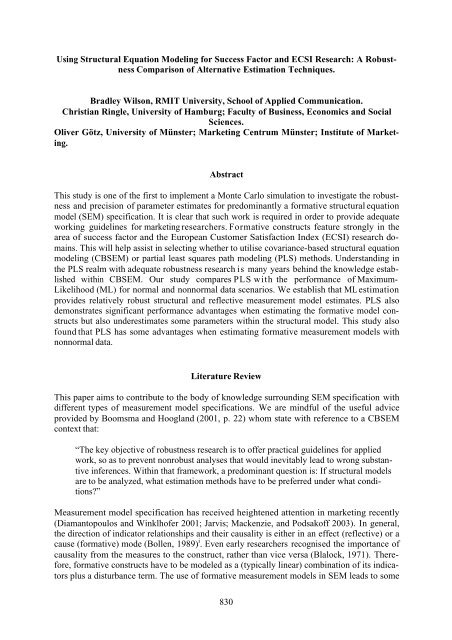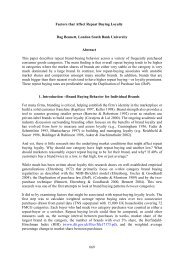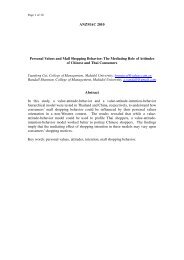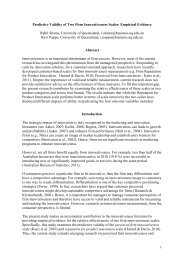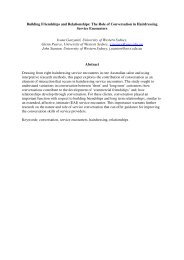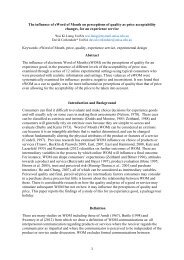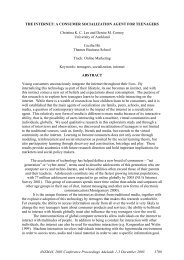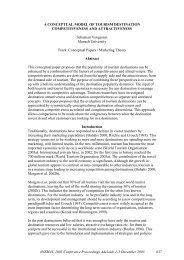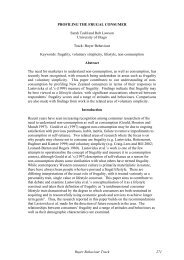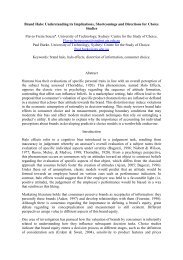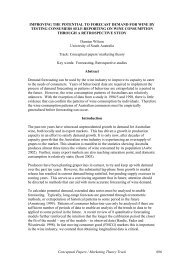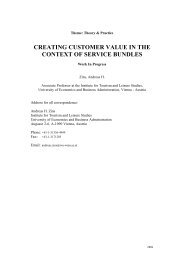Using Structural Equation Modeling for Success Factor ... - ANZMAC
Using Structural Equation Modeling for Success Factor ... - ANZMAC
Using Structural Equation Modeling for Success Factor ... - ANZMAC
Create successful ePaper yourself
Turn your PDF publications into a flip-book with our unique Google optimized e-Paper software.
<strong>Using</strong> <strong>Structural</strong> <strong>Equation</strong> <strong>Modeling</strong> <strong>for</strong> <strong>Success</strong> <strong>Factor</strong> and ECSI Research: A Robustness<br />
Comparison of Alternative Estimation Techniques.<br />
Bradley Wilson, RMIT University, School of Applied Communication.<br />
Christian Ringle, University of Hamburg; Faculty of Business, Economics and Social<br />
Sciences.<br />
Oliver Götz, University of Münster; Marketing Centrum Münster; Institute of Marketing.<br />
Abstract<br />
This study is one of the first to implement a Monte Carlo simulation to investigate the robustness<br />
and precision of parameter estimates <strong>for</strong> predominantly a <strong>for</strong>mative structural equation<br />
model (SEM) specification. It is clear that such work is required in order to provide adequate<br />
working guidelines <strong>for</strong> marketing researchers. Formative constructs feature strongly in the<br />
area of success factor and the European Customer Satisfaction Index (ECSI) research domains.<br />
This will help assist in selecting whether to utilise covariance-based structural equation<br />
modeling (CBSEM) or partial least squares path modeling (PLS) methods. Understanding in<br />
the PLS realm with adequate robustness research is many years behind the knowledge established<br />
within CBSEM. Our study compares PLS with the per<strong>for</strong>mance of Maximum-<br />
Likelihood (ML) <strong>for</strong> normal and nonnormal data scenarios. We establish that ML estimation<br />
provides relatively robust structural and reflective measurement model estimates. PLS also<br />
demonstrates significant per<strong>for</strong>mance advantages when estimating the <strong>for</strong>mative model constructs<br />
but also underestimates some parameters within the structural model. This study also<br />
found that PLS has some advantages when estimating <strong>for</strong>mative measurement models with<br />
nonnormal data.<br />
Literature Review<br />
This paper aims to contribute to the body of knowledge surrounding SEM specification with<br />
different types of measurement model specifications. We are mindful of the useful advice<br />
provided by Boomsma and Hoogland (2001, p. 22) whom state with reference to a CBSEM<br />
context that:<br />
“The key objective of robustness research is to offer practical guidelines <strong>for</strong> applied<br />
work, so as to prevent nonrobust analyses that would inevitably lead to wrong substantive<br />
inferences. Within that framework, a predominant question is: If structural models<br />
are to be analyzed, what estimation methods have to be preferred under what conditions?”<br />
Measurement model specification has received heightened attention in marketing recently<br />
(Diamantopoulos and Winklhofer 2001; Jarvis; Mackenzie, and Podsakoff 2003). In general,<br />
the direction of indicator relationships and their causality is either in an effect (reflective) or a<br />
cause (<strong>for</strong>mative) mode (Bollen, 1989) i . Even early researchers recognised the importance of<br />
causality from the measures to the construct, rather than vice versa (Blalock, 1971). There<strong>for</strong>e,<br />
<strong>for</strong>mative constructs have to be modeled as a (typically linear) combination of its indicators<br />
plus a disturbance term. The use of <strong>for</strong>mative measurement models in SEM leads to some<br />
830
implications <strong>for</strong> researchers. One implication <strong>for</strong> a <strong>for</strong>mative specification is that deleting one<br />
indicator could omit a unique part of the measurement model and change the domain meaning<br />
of the construct (Diamantopoulos and Winklhofer, 2001). Thus, some researchers state that a<br />
<strong>for</strong>mative measurement model requires a census of all indicators that determine the construct<br />
(Bollen and Lennox 1991). Often <strong>for</strong>mative indicators do not follow a multinormal distribution.<br />
Social research often leads to nonnormal item distribution curves, with varying degrees<br />
of skewness and kurtosis which can strongly influence the choice of SEM estimator (Browne,<br />
1984). Two main approaches have been used to estimate <strong>for</strong>mative measurement models in<br />
SEM: the partial least squares (PLS) and the covariance-based (CBSEM) methods. However,<br />
little attention has been devoted to the conditions in which <strong>for</strong>mative measures and their estimation<br />
method leads to precise and robust coefficients. This study is one of the first consisting<br />
of primarily <strong>for</strong>mative variables.<br />
There are several CBSEM estimators available <strong>for</strong> analyst choice. Estimation methods include:<br />
Unweighted Least Squares (ULS), Generalized Least Squares (GLS), Maximum Likelihood<br />
(ML) and Asymptotic Distribution Free (ADF) estimation (Marcoulides and Hershberger,<br />
1997). This paper focuses on ML estimation. The inclusion of <strong>for</strong>mative measures in<br />
CBSEM is well documented by Jöreskog and Sörbom (2001) and MacCallum and Brown<br />
(1993). (Diamantopoulos 2006) recently outlined pertinent issues in <strong>for</strong>mative CBSEM identification<br />
which also supplements the work of Kline (2006) ii . Wilson, Callaghan and Stain<strong>for</strong>th<br />
(2007) instigated these suggestions in a Confirmatory Vanishing Tetrad Analysis paper.<br />
In contrast, the goal of PLS estimation is to maximise the variance of all dependent variables.<br />
There<strong>for</strong>e, the goal of PLS and CBSEM is inherently different in estimation and purpose<br />
(Chin, 1995). However, Rigdon (2003) explains that PLS is often a nontraditional alternative<br />
when undertaking analyses. PLS estimates become more accurate as PLS claims to operate on<br />
the assumption of “consistency at large” (Fornell and Cha, 1994). Whilst PLS typically overestimates<br />
structural parameters and underestimates loadings Rigdon (2003, p. 1935) states<br />
“that this is a reasonable trade….to estimate essentially hypothetical model parameters <strong>for</strong> an<br />
improved ability to predict the data.”<br />
The Vilares, Almeida, and Coelho (2007) study comes the closest to a PLS Monte Carlo investigation<br />
featuring one <strong>for</strong>mative construct specification with the balance of constructs in<br />
their research being a reflective orientation. Their scenarios include: a symmetric base model<br />
and one with skewed data. They also use as the basis <strong>for</strong> their work the reduced <strong>for</strong>m of the<br />
European Customer Satisfaction Index (ECSI) model stating that debate exists about whether<br />
the loyalty construct is best represented by reflective or <strong>for</strong>mative indicators. They generate<br />
1000 simulated datasets <strong>for</strong> 250 observations <strong>for</strong> 21 measured variables. (Chin; Marcolin, and<br />
Newstead 2003)) and Hsu, Chen, and Hsieh (2006) both complete simulation studies but they<br />
only focus on constructs with reflective specifications. Some studies ((Fornell and Bookstein<br />
1982); Lohmöller, 1989; Tenenhaus et al., 2005) iii have CBSEM (ML estimation) and PLS estimation<br />
comparisons but these were not <strong>for</strong> Monte Carlo studies.<br />
Formative models have been prevalent within business and marketing success factor research<br />
(c.f., Lee and Tsang, 2001; Höck and Ringle, 2006; Wixom and Watson, 2001). These indicators<br />
are usually independent drivers of the success factor. The model we specify is also similar<br />
to models that have been studied <strong>for</strong> ECSI investigations (Gronholdt, Martensen and Kristensen,<br />
2000; Kristensen, Martensen and Gronholdt, 2000). Many studies of this nature typically<br />
have response profiles that do not meet the normality assumption.<br />
831
Monte Carlo Study Design<br />
The graphical model investigated is analogous to the constructs and relations in the ECSI and<br />
the prespecified relationships are featured in Table 2 (see first column). The manifest variables<br />
in the measurement models of the exogenous constructs are operationalised as <strong>for</strong>mative<br />
while the endogenous constructs are measured reflectively. This model is appropriate <strong>for</strong><br />
CBSEM (Jöreskog and Sörbom, 2001) and PLS path modeling (Lohmöller, 1989; Tenenhaus<br />
et al., 2005). The design specification <strong>for</strong> the investigated SEM is partially based on Albers<br />
and Hildebrand (2006) who analyse the effect of invalid scale purification. We created a correlation<br />
matrix <strong>for</strong> data generation (Table 1). A STATISTICA 7.1 (StatSoft, 2005) macro implementation<br />
was programmed to simulate data. The data generation process is consistent<br />
with the procedure described by Chin, Marcolin and Newsted (2003) and Vilares, Almeida,<br />
and Coelho (2007). The Monte Carlo simulation comprises 1000 sets of normal data whereby<br />
each set consists of 300 cases. In addition, we carried out a separate analysis <strong>for</strong> extremely<br />
nonnormal data regarding skewness (2) and kurtosis (8). The CBSEM as well as PLS model<br />
estimations <strong>for</strong> each set of data provide proper solutions (convergence, model identification<br />
and heywood cases). CBSEM results are obtained via STATISTICA while SmartPLS (Ringle,<br />
Wende and Will, 2006) is used <strong>for</strong> the PLS path modeling.<br />
Table 1: Correlation Matrix of Manifest Variables (Albers & Hildebrandt, 2006)<br />
x1 x2 x3 x4 x5 x6 x7 x8 x9 x10 x11 x12 x13 y1 y2 y3 y4 y5 y6<br />
x1 1.00<br />
x2 0.71 1.00<br />
x3 0.72 0.65 1.00<br />
x4 0.08 0.04 0.09 1.00<br />
x5 -0.01 -0.05 -0.02 0.05 1.00<br />
x6 0.02 0.03 -0.06 0.06 -0.03 1.00<br />
x7 -0.11 -0.12 -0.06 0.00 0.02 -0.01 1.00<br />
x8 -0.13 -0.13 -0.09 -0.05 0.01 0.06 0.10 1.00<br />
x9 0.02 -0.03 0.00 0.06 0.00 -0.02 0.10 -0.06 1.00<br />
x10 0.01 0.07 -0.01 0.03 0.12 -0.03 -0.02 -0.01 0.12 1.00<br />
x11 -0.05 0.04 -0.06 0.07 0.00 0.07 0.01 -0.04 0.24 0.57 1.00<br />
x12 0.03 0.07 -0.02 0.10 0.06 -0.02 0.02 -0.05 0.29 0.49 0.53 1.00<br />
x13 0.03 0.05 0.01 -0.01 0.01 0.05 0.00 -0.01 0.13 0.20 0.29 0.27 1.00<br />
y1 0.06 0.06 0.05 0.54 0.61 0.15 0.19 0.01 0.08 0.08 0.03 0.06 -0.02 1.00<br />
y2 0.00 0.02 0.00 0.54 0.51 0.19 0.16 0.01 0.10 0.04 0.02 0.04 -0.01 0.85 1.00<br />
y3 0.08 0.06 0.08 0.54 0.58 0.09 0.15 0.04 0.11 0.01 0.00 0.03 0.00 0.89 0.83 1.00<br />
y4 0.06 0.07 0.04 0.33 0.30 0.29 0.36 0.04 0.33 0.37 0.39 0.42 0.32 0.58 0.53 0.55 1.00<br />
y5 0.00 0.01 0.01 0.31 0.28 0.26 0.40 0.09 0.29 0.35 0.38 0.35 0.34 0.54 0.51 0.52 0.83 1.00<br />
y6 0.05 0.05 0.01 0.35 0.35 0.29 0.40 0.07 0.35 0.37 0.41 0.39 0.36 0.63 0.57 0.58 0.88 0.86 1.00<br />
Results and Conclusion<br />
Our simulation study establishes five main findings. First, the CBSEM and PLS estimates <strong>for</strong><br />
the simulated sets of data are on average very close to the population parameters. ML provides<br />
the most appropriate CBSEM estimates in our simulations study. This mirrors results<br />
obtained in a cross-sectional study illustrating high correlations between ML estimates and<br />
PLS estimates (Tenenhaus et al., 2005). The reader should consult Table 2 and 3 <strong>for</strong> complete<br />
understanding of the below stated findings. Second, ML has a tendency of overestimating<br />
while PLS has a tendency of underestimating parameters in the <strong>for</strong>mative measurement mod-<br />
832
els. Both methods per<strong>for</strong>m considerably better in the <strong>for</strong>mative measurement model with a<br />
homogenous correlation pattern compared to the two with heterogeneous correlation patterns.<br />
Third, ML has a tendency to underestimate and PLS to overestimate parameters in reflective<br />
outer models. Fourth, ML overestimates inner relationships data while PLS underestimates<br />
those parameters. The accuracy (mean absolute deviation, MAD) <strong>for</strong> the inner relationships<br />
between exogenous and endogenous constructs with different kinds of measurement models<br />
has a considerably weaker outcome, especially <strong>for</strong> PLS. Fifth, CBSEM estimates in the <strong>for</strong>mative<br />
measurement and the structural model significantly decrease in their accuracy and robustness<br />
(mean squared error, MSE) when data is nonnormal while the per<strong>for</strong>mance <strong>for</strong> reflective<br />
measurement models is not affected by the changed data characteristics. The results<br />
<strong>for</strong> PLS show that the decrease of MSE and MAD is at much lower levels making it suitable<br />
<strong>for</strong> nonnormal data (Table 4).<br />
Table 2: Simulation Results <strong>for</strong> Normal Data<br />
Mean<br />
Mean Absolute<br />
Mean Value Deviation<br />
Deviation Mean Squared Error<br />
Outer Model (Formative) ML PLS ML PLS ML PLS ML PLS<br />
[x1]-{0.1}->(Ksi1) 0.107 0.085 0.008 -0.018 0.135 0.226 0.034 0.080<br />
[x2]-{0.2}->(Ksi1) 0.210 0.177 0.010 -0.026 0.142 0.236 0.046 0.085<br />
[x3]-{0.1}->(Ksi1) 0.105 0.084 -0.004 -0.023 0.137 0.230 0.053 0.079<br />
[x4]-{0.6}->(Ksi1) 0.610 0.452 -0.003 -0.137 0.156 0.234 0.195 0.090<br />
[x5]-{0.4}->(Ksi1) 0.421 0.308 -0.000 -0.078 0.151 0.222 0.220 0.081<br />
[x6]-{0.4}->(Ksi2) 0.433 0.413 0.024 0.020 0.113 0.210 0.081 0.068<br />
[x7]-{0.6}->(Ksi2) 0.649 0.600 0.040 0.000 0.144 0.179 0.112 0.052<br />
[x8]-{0.1}->(Ksi2) 0.102 0.098 0.001 0.001 0.103 0.213 0.018 0.072<br />
[x9]-{0.4}->(Ksi3) 0.408 0.329 0.006 -0.075 0.088 0.154 0.015 0.038<br />
[x10]-{0.3}->(Ksi3) 0.300 0.244 -0.003 -0.057 0.089 0.150 0.015 0.036<br />
[x11]-{0.2}->(Ksi3) 0.199 0.160 0.001 -0.035 0.085 0.146 0.013 0.033<br />
[x12]-{0.2}->(Ksi3) 0.203 0.166 0.003 -0.030 0.093 0.145 0.015 0.033<br />
[x13]-{0.4}->(Ksi3) 0.407 0.321 0.008 -0.073 0.095 0.148 0.018 0.035<br />
Average(abs) 0.008 0.044 0.118 0.192 0.064 0.060<br />
Outer Model (Reflective)<br />
(Eta1)-{0.8}->[y1] 0.682 0.841 -0.115 0.041 0.125 0.041 0.019 0.002<br />
(Eta1)-{0.7}->[y2] 0.648 0.816 -0.049 0.117 0.072 0.117 0.008 0.014<br />
(Eta1)-{0.8}->[y3] 0.682 0.842 -0.114 0.042 0.124 0.042 0.019 0.002<br />
(Eta2)-{0.8}->[y4] 0.765 0.871 -0.038 0.071 0.064 0.071 0.007 0.005<br />
(Eta2)-{0.7}->[y5] 0.720 0.851 0.017 0.151 0.050 0.151 0.005 0.023<br />
(Eta2)-{0.8}->[y6] 0.766 0.871 -0.036 0.072 0.062 0.072 0.006 0.005<br />
Average(abs) 0.062 0.082 0.083 0.082 0.011 0.009<br />
Inner Model<br />
(Ksi1)-{0.4}->(Eta1) 0.398 0.249 -0.001 -0.025 0.048 0.151 0.007 0.025<br />
(Ksi2)-{0.5}->(Eta1) 0.509 0.254 0.005 -0.064 0.072 0.250 0.015 0.064<br />
(Ksi3)-{0.6}->(Eta1) 0.607 0.382 0.002 -0.051 0.057 0.221 0.008 0.051<br />
(Eta1)-{0.6}->(Eta2) 0.597 0.580 0.001 -0.002 0.038 0.035 0.004 0.002<br />
Average(abs) 0.002 0.036 0.054 0.164 0.009 0.036<br />
Mean Value =<br />
1<br />
n<br />
n<br />
ˆ å q i<br />
i = 1<br />
;<br />
n 1<br />
Mean Deviation = ˆ å qi<br />
- q ;<br />
n i = 1<br />
n 1<br />
Mean Absolute Deviation = ˆ å qi<br />
- q<br />
n i = 1<br />
;<br />
1<br />
Mean Squared Error =<br />
n<br />
n<br />
2<br />
( qˆ<br />
i - q)<br />
;<br />
i = 1,...,<br />
1000 ; θ Parameter Estimation ;<br />
ˆ = θ =<br />
Population<br />
Parameter<br />
å<br />
i = 1<br />
833
In conclusion, <strong>for</strong>mative CBSEM provides accurate and robust parameter estimates that are in<br />
some ways superior in comparison to PLS when dealing with normal data (Table 4). However,<br />
in most marketing applications, we are probably dealing with relatively small sample<br />
sizes and skewed data that may not be appropriate to provide ML robust estimates with <strong>for</strong>mative<br />
variables. ML may not be as robust to normality deviations (Bollen, 1989; Boomsma,<br />
1983) with <strong>for</strong>mative models. Consequently, PLS is recommended as the methodology of<br />
choice with this kind of data and model specification. Although, no CBSEM convergence<br />
problems were featured in this study, other <strong>for</strong>mative models may be difficult to identify<br />
and/or have convergence problems (Fornell and Bookstein, 1982). PLS has demonstrated advantages<br />
here (Chin, 1998; Wilson, 2007). Future simulations must investigate different<br />
model types with varied parameter combinations, variable numbers (item reliabilities), sample<br />
sizes and newer CBSEM estimators that may be sensitive to categorical nonnormal variables<br />
(Finney and DiStefano, 2006).<br />
834
Table 3: Simulation Results <strong>for</strong> Nonnormal Data<br />
Mean Value<br />
Mean<br />
Deviation Mean Absolute Deviation Mean Squared Error<br />
Outer Model (Formative) ML PLS ML PLS ML PLS ML PLS<br />
[x1]-{0.1}->(Ksi1) 0.104 0.084 0.004 -0.016 0.163 0.245 0.052 0.093<br />
[x2]-{0.2}->(Ksi1) 0.215 0.178 0.015 -0.022 0.168 0.248 0.070 0.096<br />
[x3]-{0.1}->(Ksi1) 0.110 0.084 0.010 -0.016 0.154 0.238 0.045 0.085<br />
[x4]-{0.6}->(Ksi1) 0.612 0.453 0.012 -0.147 0.196 0.247 0.310 0.098<br />
[x5]-{0.4}->(Ksi1) 0.418 0.307 0.018 -0.093 0.168 0.248 0.088 0.097<br />
[x6]-{0.4}->(Ksi2) 0.445 0.412 0.045 0.012 0.150 0.229 0.264 0.084<br />
[x7]-{0.6}->(Ksi2) 0.655 0.602 0.055 0.002 0.185 0.204 0.260 0.065<br />
[x8]-{0.1}->(Ksi2) 0.103 0.095 0.003 -0.005 0.120 0.225 0.027 0.080<br />
[x9]-{0.4}->(Ksi3) 0.418 0.329 0.018 -0.071 0.115 0.172 0.030 0.047<br />
[x10]-{0.3}->(Ksi3) 0.307 0.243 0.007 -0.057 0.111 0.168 0.024 0.044<br />
[x11]-{0.2}->(Ksi3) 0.203 0.159 0.003 -0.041 0.112 0.164 0.022 0.042<br />
[x12]-{0.2}->(Ksi3) 0.211 0.167 0.011 -0.033 0.121 0.165 0.025 0.042<br />
[x13]-{0.4}->(Ksi3) 0.413 0.318 0.013 -0.082 0.118 0.172 0.032 0.047<br />
Outer Model (Reflective)<br />
Average(abs) 0.016 0.046 0.145 0.210 0.096 0.071<br />
(Eta1)-{0.8}->[y1] 0.682 0.842 -0.118 0.042 0.132 0.044 0.023 0.002<br />
(Eta1)-{0.7}->[y2] 0.648 0.817 -0.052 0.117 0.083 0.117 0.011 0.014<br />
(Eta1)-{0.8}->[y3] 0.682 0.842 -0.118 0.042 0.132 0.044 0.023 0.002<br />
(Eta2)-{0.8}->[y4] 0.766 0.872 -0.034 0.072 0.074 0.072 0.010 0.006<br />
(Eta2)-{0.7}->[y5] 0.720 0.851 0.020 0.151 0.066 0.151 0.008 0.023<br />
(Eta2)-{0.8}->[y6] 0.767 0.871 -0.033 0.071 0.074 0.071 0.009 0.005<br />
Inner Model<br />
Average(abs) 0.063 0.082 0.094 0.083 0.014 0.009<br />
(Ksi1)-{0.4}->(Eta1) 0.397 0.250 -0.003 -0.025 0.058 0.150 0.009 0.025<br />
(Ksi2)-{0.5}->(Eta1) 0.503 0.255 0.003 -0.063 0.082 0.245 0.020 0.063<br />
(Ksi3)-{0.6}->(Eta1) 0.601 0.384 0.001 -0.050 0.077 0.216 0.014 0.050<br />
(Eta1)-{0.6}->(Eta2) 0.596 0.582 -0.004 -0.002 0.048 0.039 0.007 0.002<br />
Mean<br />
Value<br />
=<br />
Mean Squared Error<br />
Average(abs) 0.003 0.035 0.066 0.162 0.012 0.035<br />
1<br />
n<br />
1<br />
=<br />
n<br />
n<br />
å<br />
i = 1<br />
n<br />
å<br />
i = 1<br />
qˆ<br />
i<br />
;<br />
2<br />
( qˆ<br />
- q)<br />
i<br />
Mean Deviation<br />
;<br />
i = 1,...,<br />
1000<br />
n 1<br />
= ˆ å qi<br />
- q ;<br />
n i = 1<br />
n 1<br />
Mean Absolute Deviation = ˆ å qi<br />
- q<br />
n i = 1<br />
;<br />
; θ Parameter Estimation ;<br />
ˆ = θ = Population<br />
Parameter<br />
Table 4: Comparison of Simulation Results <strong>for</strong> Normal and Nonnormal Data<br />
Relative Absolute Changes between<br />
Normal and Non-Normal Parameter Estimations<br />
Mean Absolute Deviation Mean Squared Error<br />
ML PLS ML PLS<br />
Outer Model (Formative) 0.228 0.093 0.495 0.178<br />
Outer Model (Reflective) 0.131 0.008 0.311 0.029<br />
Inner Model 0.229 -0.011 0.432 -0.019<br />
Average MADnormal<br />
- Average MADnonnormal<br />
Relative MAD Change =<br />
Average MAD<br />
;<br />
Relative MSE Change<br />
=<br />
Average MSE<br />
normal<br />
Average MSE<br />
normal<br />
- Average MSE<br />
normal<br />
835<br />
nonnormal
References<br />
Albers, S., Hildebrandt, L., 2006. Methodische Probleme bei der Erfolgsfaktoren<strong>for</strong>schung –<br />
Messfehler, versus reflektive Indikatoren und die Wahl des Strukturgleichungs-Modells.<br />
Schmalenbachs Zeitschrift für betriebswirtschaftliche Forschung 58 (1), 2-33.<br />
Anderson, E.W., Fornell, C., Lehmann, D.R., 1994. Customer satisfaction, market share, and<br />
profitability: Findings from Sweden. Journal of Marketing 58 (3), 53-67.<br />
Blalock, H.M., 1971. Causal models involving unmeasured variables in stimulus-response<br />
situations. In Blalock, H.M. (Ed.), Causal models in the social science. Aldine Atherton. Chicago,<br />
New York, pp. 335-347.<br />
Bollen, K.A., 1989. <strong>Structural</strong> equations with latent variables. Wiley. New York.<br />
Bollen, K.A., Lennox, R., 1991. Conventional Wisdom on Measurement: A <strong>Structural</strong> <strong>Equation</strong><br />
Perspective. Psychological Bulletin 110 (2), 305-314.<br />
Boomsma, A., 1983. On the robustness of LISREL (maximum likelihood estimation) against<br />
small sample size and nonnormality. University of Groningen, Groningen. Unpublished doctoral<br />
dissertation.<br />
Boomsma, A., Hoogland, J.J., 2001. The robustness of LISREL modeling revisited. In R.<br />
Cudeck, R., du Toit, S., Sörbom, D., (Eds.), <strong>Structural</strong> equation modeling: Present and future.<br />
Scientific Software International. Chicago, pp. 139-168.<br />
Browne, M.W., 1984. Asymptotically distribution-free methods <strong>for</strong> the analysis of covariance<br />
structures. British Journal of Mathematical and Statistical Psychology 37, 62-83.<br />
Chin, W. W., 1995. Partial Least Squares is to LISREL as Principal Components Analysis is<br />
to Common <strong>Factor</strong> Analysis. Technological Studies 2, 315-319.<br />
Chin, W.W., 1998. The Partial Least Squares Approach to <strong>Structural</strong> <strong>Equation</strong> <strong>Modeling</strong>. In<br />
Marcoulides, G.A., (Ed.), Modern Methods <strong>for</strong> Business Research. Lawrence Erlbaum, Mahwah,<br />
New Jersey, 295-336.<br />
Chin, W.W., Marcolin, B.L., Newsted, P.R., 2003. A partial least squares latent variable modeling<br />
approach <strong>for</strong> measuring interaction effects: Results from a Monte Carlo simulation study<br />
and an electronic-mail emotion / adoption study. In<strong>for</strong>mation Systems Research 14 (2), 189-<br />
217.<br />
Diamantopoulos, A., 2006. The error term in <strong>for</strong>mative measurement models: interpretation<br />
and modeling implications. Journal of Modelling in Management 1 (1), 7-17.<br />
Diamantopoulos, A., Winklhofer, H.M., 2001. Index construction with <strong>for</strong>mative indicators:<br />
An alternative to scale development. Journal of Marketing Research 38, 269-277.<br />
Edwards, J.R., Bagozzi, R.P., 2000. On the nature and direction of relationships between constructs<br />
and measures. Psychological Methods 5 (2), 155-174.<br />
836
Finney, S. J., DiStefano, C., 2006. Non-normal and Categorical Data in <strong>Structural</strong> <strong>Equation</strong><br />
<strong>Modeling</strong>. in Hancock, G. R. and Mueller, R. O. (Eds.) <strong>Structural</strong> <strong>Equation</strong> <strong>Modeling</strong>: A Second<br />
Course. Greenwich: IAP- In<strong>for</strong>mation Age Publishing., 269-314.<br />
Fornell, C., Bookstein, F.L., 1982. Two <strong>Structural</strong> <strong>Equation</strong> Models: LISREL and PLS Applied<br />
to Consumer Exit-Voice Theory. Journal of Marketing Research 19 (November), 440-<br />
452.<br />
Fornell, C., Cha, J., 1994. Partial least squares. in .Bagozzi, R. P. (Ed.) Advanced Methods of<br />
Marketing Research. Basil Blackwell Ltd. Ox<strong>for</strong>d. pp. 52-78.<br />
Fornell, C., Johnson, M.D., Anderson, E.W., Cha, J., Bryant, B.E., 1996. The American Customer<br />
Satisfaction Index: Nature, purpose, and findings. Journal of Marketing. 60 (4), 7-19.<br />
Gronholdt, L., Martensen, A., Kristensen, K., 2000. The Relationship between Customer Satisfaction<br />
and Loyalty: Cross-Industry Differences. Total Quality Management 11 (4/5/6), 509-<br />
514.<br />
Höck, M., Ringle, C.M., 2006. Strategic networks in the software industry: An empirical<br />
analysis of the value continuum, IFSAM VIII th World Congress, Berlin.<br />
Hsu, H.-H., Chen, W.-H., Hsieh, M.-J., 2006. Robustness testing of PLS, LISREL, EQS and<br />
ANN-based SEM <strong>for</strong> measuring customer satisfaction. Total Quality Management and Business<br />
Excellence 17 (3), 355-372.<br />
Jarvis, C.B., Mackenzie, S.B., Podsakoff, P.M., 2003. A Critical Review of Construct Indicators<br />
and Measurement Model Misspecification in Marketing and Consumer Research. Journal<br />
of Consumer Research 30 (September), 199-218.<br />
Jöreskog, K.G., Sörbom, D. 2001. LISREL 8. User’s reference guide. Scientific Software International.<br />
Lincolnwood.<br />
Kline, R B., 2006. Formative Measurement and Feedback Loops. in .Hancock, G. R., Mueller,<br />
R.O., (Eds.), <strong>Structural</strong> <strong>Equation</strong> <strong>Modeling</strong>: A Second Course. IAP- In<strong>for</strong>mation Age Publishing,<br />
Greenwich, 43-68.<br />
Kristensen, K., Martensen, A., Gronholdt, L., 2000. Customer Satisfaction Measurement at<br />
Post Denmark: Results of Application of the European Customer Satisfaction Index Methodology.<br />
Total Quality Management 11 (7), 1007-1015.<br />
Lee, D.Y., Tsang, E.W.K., 2001. The effects of entrepreneurial personality, background and<br />
network activities on venture growth. Journal of Management Studies 38 (4), 583-603.<br />
Lohmöller, J.-B., 1989. Latent variable path modeling with partial least squares.Physica. Heidelberg.<br />
MacCallum, R.C., Browne, M.W., 1993. The use of causal indicators in covariance structure<br />
models: Some practical issues. Psychological Bulletin 114 (3), 533-541.<br />
837
Marcoulides, G.A., Hershberger, S.L., 1997. Multivariate statistical methods: a first course.<br />
Lawrence Erlbaum Associates. Mahwah.<br />
Rigdon, E. E., 2003. <strong>Structural</strong> equation modeling: Nontraditional alternatives. In .Everitt, B.,<br />
Howell, D., (Eds.), Encyclopedia of Statistics in Behavioral Science. Wiley. New York., 4.<br />
pp. 1934-1941.<br />
Ringle, C.M., Wende, S., Will, A., 2006. SmartPLS 2.0. University of Hamburg. Hamburg.<br />
StatSoft., 2005. STATISTICA <strong>for</strong> Windows Version 7.1. www.statsoft.com.<br />
Tenenhaus, M., Vinzi, V.E., Chatelin, Y.-M., Lauro, C. 2005. PLS path modeling. Computational<br />
Statistics & Data Analysis 48 (1), 159-205.<br />
Vilares, M.J., Almeida, M.H., Coelho, P.S., 2007. Comparison of likelihood and PLS estimators<br />
<strong>for</strong> structural equation modeling: A simulation with customer satisfaction data. In Vinzi,<br />
V.E., Chin, W.W., Henseler, J., Wang, H., (Eds.), Handbook of partial least squares: concepts,<br />
methods and applications in marketing and related fields. Springer. Berlin, <strong>for</strong>thcoming.<br />
Wixom, B.H., Watson, H.J., 2001. An Empirical Investigation of the factors affecting data<br />
warehousing success. MIS Quarterly 25 (1), 17-41.<br />
Wilson, B., Callaghan, W., Stain<strong>for</strong>th, G., 2007. An Application of Vanishing TETRAD<br />
Analysis to a Brand Model. International Review of Business Research Papers 3 (2).<br />
Wilson, B., 2007. <strong>Using</strong> PLS to Investigate Interaction Effects Between Higher Order Brand<br />
Constructs. In Esposito Vinzi, V., Chin, W. W., Henseler, J., and Wang, H. (Eds.), Handbook<br />
of Partial Least Squares: Concepts, Methods and Applications in Marketing and Related<br />
Fields (Springer Handbooks of Computational Statistics Series). Springer Publishing, Berlin/Heidelberg.<br />
i The interested reader should consult (Bollen and Lennox, 1991; Chin, 1998; Jarvis; Mackenzie, and Podsakoff,<br />
2003) to understand measurement model specification and directionality issues.<br />
ii Formative model identification is a very difficult task with limited guidance presented in standard CBSEM articles,<br />
textbooks and software manuals. There is still much research that is needed in this realm to provide guidance<br />
<strong>for</strong> introductory and intermediate skilled modelers. We acknowledge that this is our opinion and is based on<br />
analytical experience.<br />
iii We cannot complete a full review of these studies with this limited presentation space. We are mindful of de-<br />
voting more presentation space <strong>for</strong> our own results.<br />
838


